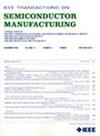A Unified Machine Learning Through Focus Resist 3-D Structure Model
IF 2.3
3区 工程技术
Q2 ENGINEERING, ELECTRICAL & ELECTRONIC
引用次数: 0
Abstract
To ensure post OPC data quality, examination based on estimated resist contours at resist bottom alone is insufficient, reliable prediction of lithography performance within process window must rely on complete information of on-wafer resist 3D structures. In this regard, resist 3D structure model, in particular, the through focus resist 3D structure model, with full chip capability will be the ultimate model in demand. To develop machine learning resist 3D structure models,we have proposed the physics-based information encoding scheme, together with carefully chosen deep convolution neural network and model training strategies. Our proposed through focus resist 3D structure model is based on conditional U-net structure with first five eigen images as model’s main inputs and the focus setting as the conditional input. The average normalized cross correlation (NCC) or mean structure similarity index between ground truth and model predicted resist 3D structures can reach 0.92. With single GPU (Tesla M60), it takes 6.1ms for the model to produce resist 3D structure covering area of 1.8umx1.8通过 Focus Resist 三维结构模型进行统一机器学习
要确保 OPC 后数据的质量,仅根据光刻胶底部的估计光刻胶轮廓进行检查是不够的,必须依靠晶圆上光刻胶三维结构的完整信息,才能可靠地预测工艺窗口内的光刻性能。在这方面,光刻胶三维结构模型,尤其是具有全芯片能力的通焦光刻胶三维结构模型,将成为最终的需求模型。为了开发机器学习光刻胶三维结构模型,我们提出了基于物理的信息编码方案,并精心选择了深度卷积神经网络和模型训练策略。我们提出的穿透焦点抗阻三维结构模型是基于条件 U-net 结构的,前五幅特征图像是模型的主要输入,焦点设置是条件输入。地面实况与模型预测的光栅三维结构之间的平均归一化交叉相关性(NCC)或平均结构相似性指数可达 0.92。使用单 GPU(Tesla M60)时,模型生成面积为 1.8umx1.8 $\mu {\mathrm{ m}}$的抗蚀三维结构需要 6.1 毫秒。该模型速度足够快,可用于全芯片实现。该模型可以扩展检测光刻工艺窗口意识到的光刻胶损耗相关热点的能力。
本文章由计算机程序翻译,如有差异,请以英文原文为准。
求助全文
约1分钟内获得全文
求助全文
来源期刊

IEEE Transactions on Semiconductor Manufacturing
工程技术-工程:电子与电气
CiteScore
5.20
自引率
11.10%
发文量
101
审稿时长
3.3 months
期刊介绍:
The IEEE Transactions on Semiconductor Manufacturing addresses the challenging problems of manufacturing complex microelectronic components, especially very large scale integrated circuits (VLSI). Manufacturing these products requires precision micropatterning, precise control of materials properties, ultraclean work environments, and complex interactions of chemical, physical, electrical and mechanical processes.
 求助内容:
求助内容: 应助结果提醒方式:
应助结果提醒方式:


